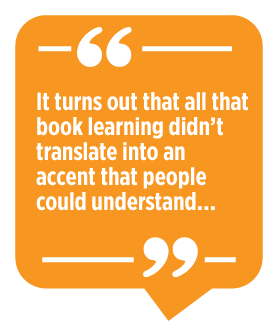|
 I learned Spanish from a textbook: I memorized vocabulary and conjugated the heck out of verbs. I was a near genius when it came to filling in the worksheets my teacher gave us. I learned Spanish from a textbook: I memorized vocabulary and conjugated the heck out of verbs. I was a near genius when it came to filling in the worksheets my teacher gave us.
And then my family moved to Central America, and I spent nearly 6 months afraid to open my mouth and another 3 trying desperately to be understood.
It turns out that all that book learning didn’t translate into an accent that people could understand, nor did all that memorized vocabulary help me to string more than a few words together in a meaningful way. It was only after I gained confidence and began to interact with native speakers that I really began to use this new language correctly in a meaningful way.
I carried this lesson with me when I began my career as an English to speakers of other languages (ESOL) instructor working with adults. I understood that the reason my students loved their worksheets and their textbooks was because they were a safe way to practice the language. I also recognized the abject fear in their eyes when they had to go out into the English-speaking world at the end of the day. I wondered how I might ease some of this stress by helping them gain the confidence they needed to navigate this new language and culture.
 I knew from my own experience that the best language classroom was outside my classroom window. How could I engage my students using what I saw out there in the real world? With this in mind, I began a quest to identify ways to use the resources in my community as an integral part of my classroom teachings. Though I will admit that there were a few real “bombs,” there were others that have become a part of my curriculum. Here are the things I have tried that really worked in both my day and evening ESOL classes: I knew from my own experience that the best language classroom was outside my classroom window. How could I engage my students using what I saw out there in the real world? With this in mind, I began a quest to identify ways to use the resources in my community as an integral part of my classroom teachings. Though I will admit that there were a few real “bombs,” there were others that have become a part of my curriculum. Here are the things I have tried that really worked in both my day and evening ESOL classes:
1. Scavenger Hunts
A scavenger hunt can be done anywhere—in the building where your class is held, in the neighborhood, in the school library, or anyplace else that forces your students up and out of their chairs!
Yes, this requires a bit of prep work, but once it’s done you only have to refine things based on what worked and what didn’t. Always review the written instructions together and go over any questions students may have. Place students in mixed-ability groups of two to four and send each group off in different directions (but always going to the same places). The hunt requires them to ask questions of people at certain stops, take a selfie at others, and find the answer to a question about what they saw at other locations (see the Appendix for a scavenger hunt example). The entire exercise typically takes 30 minutes, and another 10–15 to discuss what they learned.
Alternative:Another simple, no-prep option can be to take students to a local museum; most have already put together scavenger hunts for K–12 field trip groups—all you need to do is ask for a copy (see an example from the Charleston Museum).
2. Volunteer in the Community
Every city/town has at least one organization that would welcome your student’s help. Sorting food at the food bank helped my students learn meaningful food vocabulary. They also had to follow specific directions in English and be able to read and understand signs over bins that told them what was supposed to go into them. We also toured the local homeless shelter and learned about what they did.
These field trips led to the creation of an entire learning unit on nonprofit organizations that we return to at least once a year. This unit requires advanced students to research and write papers and give PowerPoint presentations about a specific organization. Intermediate and beginner students prepare poster presentations to discuss with their classes.
3. Interview a Local Business
After I reached out to a few local businesses, I realized that people were more than willing to talk to my students about their jobs and their businesses. So, after clearing a day and time with them, students are placed in pairs and assigned a business to visit. Before setting out, everyone brainstorms questions that they would like to ask and practice what they will say. The culmination of this exercise is a paper summarizing what they learned. (Lower level students write out the questions and then write the answers they were given.) All of the groups present their interviews to the class using pictures they took during their visit. This assignment ticks every ESOL skills box and builds confidence in students’ ability to understand and communicate in English.
Alternative: Send students out to ask people about their jobs at your school; this a wonderful way for them to feel connected to the school community and to gain an appreciation for what others do to support them in the learning.

4. Go Out to Lunch or Dinner as a Group
This is a tried and true method for the final day or evening of most adult ESL classes, but I find that doing it in the beginning of the term encourages the students to bond, and it also helps them get over the initial “I can’t speak English” jitters they all have.
5. Attend a Local Sporting Event
American sports, especially baseball and football, are not something most of my students know anything about. The opportunity to go to a minor league ball game or experience a college basketball or football game is an inexpensive, unique, and exciting experience. Before going, work on specific sports vocabulary and talk about the rules of the game and how it is played. (A PowerPoint works well for this.)
After the game, spend time discussing how the sport is similar or different from one that is popular in their country. You can have students give talks or write papers about their favorite sport or player. Advanced students can also write compare and contrast essays on different sports. If your group is big enough, you can divide into teams and play a short game, too!
I always tell my students that there’s a big difference between “knowing” a language and “using” a language. These types of real-world experiences are the bridges that connect our classes to the outside world and make it easier for them to find their way on their own, once they get across.
Penny Aber-Kahn is the academic coordinator of the English Language Institute at the College of Charleston, South Carolina. She has taught extensively in both U.S. college/university ESOL programs, as well as in community-based programs. She has developed curriculum for numerous colleges and state agencies and has led professional workshops on topics ranging from teaching writing to second language learners to incorporating games into the ESOL classroom.
|